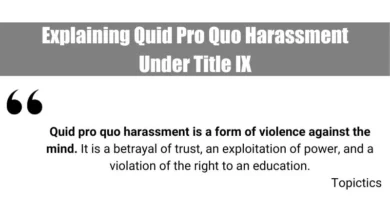What Does Status Quo Mean in A Relationship?
In a relationship, “status quo” refers to maintaining the existing state of affairs without significant changes. This concept involves keeping the current level of intimacy, routines, and dynamics steady, avoiding major shifts that could alter the relationship’s balance. While some couples actively work to sustain this equilibrium, others may unconsciously adhere to it due to habits or fear of disrupting their comfort zone.
However, an excessive attachment to the status quo can lead to complacency, potentially causing dissatisfaction if issues are left unaddressed. Recognizing and understanding the status quo in a relationship is crucial, as it allows partners to evaluate whether maintaining it serves their mutual well-being or if adjustments are needed for healthier dynamics.
Takeaways
| Key Points |
|---|
| In relationships, the status quo refers to maintaining existing patterns, routines, and emotional dynamics without initiating meaningful change, often to preserve comfort and avoid conflict. |
| This steady state offers predictability and security, enabling couples to build shared history and deepen mutual understanding, yet it can also limit growth, mask unresolved issues, and foster emotional stagnation. |
| Psychological elements such as comfort zones, fear of change, and status quo bias significantly influence partners’ resistance to transformation, often leading them to rationalize unsatisfying dynamics in favor of familiarity. |
| However, recognizing signs like persistent unhappiness, recurring conflicts, or emotional detachment is crucial for challenging the status quo constructively through open communication, gradual adjustments, and shared goal-setting. |
| Ultimately, balancing the desire for stability with the need for development requires deliberate, mutual efforts to evolve the relationship while preserving the foundational elements that nurture trust and connection. |
Definition of Status Quo in Relationships
The term “status quo” originates from Latin, meaning “the existing state of affairs.” In the context of relationships, maintaining the status quo refers to keeping the current dynamics, routines, and levels of intimacy unchanged. This implies that both partners continue their established patterns without introducing significant alterations or addressing underlying issues.
Understanding the Concept of Status Quo
Origins and Meaning of ‘Status Quo’
The phrase “status quo” is derived from the Latin expression “in statu quo,” translating to “in the state in which.” Historically, it has been used to describe the existing condition of affairs, particularly in political and social contexts. In relationships, it signifies the current state of the partnership, encompassing habits, roles, and interactions that have become customary over time.
Application of Status Quo in Relationship Contexts
In relationships, maintaining the status quo often involves adhering to familiar routines and avoiding changes that could disrupt the established equilibrium. This can manifest in various ways, such as continuing habitual communication patterns, preserving traditional roles, or avoiding discussions about unresolved issues.
While this can provide a sense of security, it may also prevent the relationship from evolving and addressing necessary growth areas.
The Role of Status Quo in Relationship Maintenance
Maintaining Stability and Predictability
One of the primary roles of maintaining the status quo in relationships is to provide stability and predictability. Partners often find comfort in familiar patterns, which can create a sense of security and trust. This consistency allows individuals to anticipate each other’s behaviors and responses, fostering a harmonious environment. However, while stability is beneficial, ensuring that it does not lead to complacency or hinder personal and relational growth is essential.
Avoiding Disruptions and Conflicts
Couples may aim to avoid potential disruptions and conflicts that can arise from change by upholding the status quo. Change often brings uncertainty, and the fear of negative outcomes may lead partners to prefer the comfort of familiar routines. This avoidance can be particularly prevalent in relationships where conflict is viewed negatively. However, consistently avoiding change to sidestep conflicts can accumulate unaddressed issues over time, potentially leading to greater dissatisfaction.
Psychological Factors Influencing Status Quo
Comfort Zones and Fear of Change
Individuals tend to develop comfort zones within their relationships, consisting of established routines and behaviors that provide a sense of safety. The fear of stepping outside these comfort zones can be a significant barrier to change. This fear is often rooted in the uncertainty of outcomes and the potential for discomfort or failure. As a result, partners may choose to maintain the status quo, even when it is no longer fulfilling or beneficial.
System Justification Theory and Its Impact
System Justification Theory posits that individuals have a psychological tendency to defend and justify the existing social, economic, and political systems, even when they may be disadvantageous. In the context of relationships, this theory suggests that partners may rationalize and support the current state of their relationship to maintain a sense of order and stability.
This justification can lead to resistance to change, as individuals may perceive the existing dynamics as legitimate and preferable despite potential drawbacks.
Benefits of Maintaining the Status Quo
Preserving the status quo can offer notable advantages in relationships, fostering stability and deepening mutual understanding.
Ensuring Consistency and Security
Predictable behaviors and responses from partners cultivate reliability and trust. This predictability reduces uncertainty, alleviating stress and enabling couples to navigate external challenges together confidently.
Building a Shared History and Understanding
Continuing established routines allows couples to accumulate shared experiences and traditions, strengthening their bond. Over time, partners intuitively understand each other’s preferences and communication styles, enhancing empathy and reducing misunderstandings.
Potential Drawbacks of Status Quo in Relationships
While maintaining the status quo offers stability, it can also present challenges that may hinder personal and relational growth.
Risk of Complacency and Stagnation
Over-reliance on existing routines may lead to complacency, where partners invest less effort into nurturing their relationship. This can result in a monotonous dynamic, causing feelings of disconnection and dissatisfaction. Couples should actively seek new experiences and set shared goals to prevent stagnation.
Overlooking Unresolved Issues
Avoiding difficult conversations to maintain harmony can lead to unresolved problems festering beneath the surface. Addressing concerns promptly through open communication is crucial to prevent minor issues from escalating and to strengthen the relationship.
Impact on Personal Growth and Fulfillment
An excessive focus on preserving the current state may stifle individual growth, as partners might suppress personal aspirations to avoid disrupting the relationship’s balance. Encouraging each other’s personal development brings renewed energy and perspectives, enriching shared experiences.
Status Quo Bias and Its Effects
Understanding the psychological underpinnings of status quo bias can shed light on why individuals may resist change in relationships.
Understanding Status Quo Bias
Status quo bias is a cognitive tendency where individuals prefer the current state of affairs over alternatives, often due to a fear of potential losses associated with change. This bias makes people favor familiar situations and resist alterations, even when change might be beneficial.
How It Influences Decision-Making in Relationships
This bias can significantly impact relationship decisions. Partners may remain in unfulfilling dynamics because the prospect of change feels daunting. For example, avoiding discussions about diminishing intimacy to prevent discomfort may allow the issue to persist and worsen.
Recognizing and Overcoming Status Quo Bias
Overcoming status quo bias requires conscious effort and self-awareness. Steps to mitigate its effects include:
- Acknowledge the Bias: Recognize the natural preference for maintaining the current state.
- Evaluate the Current Situation: Assess whether existing dynamics are satisfying or if changes could enhance the relationship.
- Consider Potential Benefits of Change: Focus on positive outcomes that change could bring rather than solely on risks.
- Communicate Openly: Engage in honest discussions about desires and concerns to ensure alignment and support for potential changes.
- Start Small: Implement minor adjustments to build confidence in managing change effectively.
By actively addressing status quo bias, couples can make informed decisions that promote the health and vitality of their relationship.
Challenging the Status Quo
In any relationship, maintaining the status quo can provide comfort and stability. However, there are times when change becomes necessary to foster growth and address underlying issues. Challenging the status quo involves recognizing when change is needed, implementing strategies for constructive transformation, and communicating effectively with your partner throughout the process.
Identifying When Change Is Necessary
Recognizing the need for change is the first step toward improving a relationship. Signs that may indicate it’s time to challenge the status quo include:
- Persistent Unhappiness: When one or both partners feel consistently dissatisfied despite efforts to maintain harmony, it may signal underlying issues that need addressing.
- Repetitive Conflicts: Frequent arguments over the same issues suggest that existing solutions are ineffective, indicating a need for new approaches.
- Emotional Distance: A growing sense of detachment or lack of intimacy can point to unresolved problems or unmet needs within the relationship.
- Stagnation: If the relationship feels unprogressive, with little personal or mutual growth, it might be time to introduce changes that encourage development.
Identifying these signs requires honest self-reflection and open dialogue between partners.
Strategies for Initiating Constructive Change
Once the need for change is acknowledged, implementing it constructively is crucial. Effective strategies include:
- Setting Clear Objectives: Define specific goals for what both partners hope to achieve through the changes. This clarity helps in formulating a focused plan.
- Starting Small: Introduce minor adjustments before tackling more significant issues. Small successes can build confidence and momentum for larger changes.
- Seeking External Support: Engaging a therapist or counselor can provide professional guidance and facilitate productive discussions.
- Committing to Continuous Effort: Recognize that change is an ongoing process requiring patience, persistence, and mutual support.
Communicating Effectively with Your Partner
Effective communication is the cornerstone of successfully challenging the status quo. Key components include:
- Active Listening: Fully engage with your partner’s perspectives without interrupting or formulating responses prematurely.
- Expressing Feelings Openly: Use “I” statements to convey emotions and avoid placing blame, fostering a non-confrontational atmosphere.
- Clarifying and Confirming Understanding: Summarize your partner’s points to ensure accurate comprehension and demonstrate attentiveness.
- Scheduling Regular Check-Ins: Set aside dedicated time to discuss the relationship’s progress, addressing concerns and celebrating improvements.
Couples can navigate changes more smoothly and strengthen their bond by prioritizing open and empathetic communication.
Balancing Stability and Growth
Achieving a harmonious relationship involves integrating change without disrupting the foundational stability that provides comfort and security.
Integrating Change Without Disrupting the Relationship
To introduce change while maintaining stability:
- Maintain Core Traditions: Preserve rituals or routines that hold significant meaning to both partners, providing a sense of continuity amidst change.
- Gradual Implementation: Phase in changes incrementally to allow both partners to adjust comfortably.
- Consistent Communication: Keep the lines of dialogue open to discuss feelings about the changes, ensuring both partners feel heard and valued.
Encouraging Mutual Development and Adaptation
Fostering an environment where both partners can grow together involves:
- Supporting Individual Aspirations: Encourage each other’s personal goals and interests, recognizing that individual fulfillment contributes to the relationship’s health.
- Learning Together: As a couple, engage in new activities or educational pursuits to strengthen bonds and create shared experiences.
- Adapting to Life Transitions: Approach significant life changes as a team, collaborating on strategies to navigate new circumstances.
Setting Shared Goals and Aspirations
Establishing common objectives can align partners and provide direction:
- Regular Goal-Setting Sessions: Periodically discuss and set short-term and long-term goals that reflect mutual desires and values.
- Documenting Plans: Write down agreed-upon goals and outline steps to achieve them, creating a tangible roadmap for the relationship.
- Celebrating Milestones: Acknowledge and celebrate progress toward goals to reinforce commitment and shared accomplishment.
Balancing stability with growth requires intentional effort and collaboration, ensuring that changes enhance rather than undermine the relationship’s foundation.
Case Studies and Real-Life Examples
Examining real-life scenarios can provide valuable insights into the impact of challenging the status quo in relationships.
Scenario 1: Embracing Change for Mutual Growth
A couple, married for several years, found themselves in a routine that felt monotonous. Recognizing the need for change, they decided to pursue a new hobby together—learning a musical instrument. This shared activity not only broke their routine but also strengthened their bond through mutual learning and support.
Scenario 2: Addressing Communication Breakdown
Another couple experienced frequent misunderstandings, leading to conflicts. They sought the help of a relationship counselor who introduced them to active listening techniques. Implementing these strategies improved their communication, leading to a more harmonious relationship.
Lessons Learned from Relationship Dynamics
These examples highlight several key lessons:
- Proactive Change: Actively seeking new experiences can rejuvenate a relationship and prevent stagnation.
- Effective Communication: Investing in improving communication skills can resolve underlying issues and enhance understanding.
- Mutual Support: Collaborating on personal growth endeavors fosters closeness and shared satisfaction.
Real-life cases demonstrate that challenging the status quo may be daunting but often leads to a more fulfilling and resilient partnership.
Conclusion
Challenging the status quo in a relationship is a delicate balance between embracing change and maintaining stability. By recognizing when change is necessary, implementing strategies thoughtfully, and communicating effectively, couples can foster an environment that supports mutual growth and deepens their connection.
FAQ
What does ‘status quo’ mean in a relationship?
In a relationship, ‘status quo’ refers to maintaining the current state without significant changes. This could mean keeping the same level of commitment, routines, or dynamics, avoiding progression or regression. Partners may prefer this to preserve stability and comfort.
How does status quo bias affect relationships?
Status quo bias leads individuals to prefer existing conditions over change, even if alternatives might be beneficial. In relationships, this can result in staying in unfulfilling partnerships due to fear of the unknown or potential losses, hindering personal growth and relationship satisfaction.
Why do couples resist change in their relationship?
Couples often resist change due to loss aversion and fear of uncertainty. The comfort of familiarity makes them perceive potential changes as risks rather than opportunities, leading them to maintain the current state even if it’s suboptimal.
Can maintaining the status quo harm a relationship?
Yes, consistently maintaining the status quo can lead to stagnation. Avoiding necessary changes or growth may result in unresolved issues, decreased satisfaction, and emotional distance between partners. Proactive communication and adaptability are essential for a healthy relationship.
How can couples overcome status quo bias?
Couples can overcome status quo bias by openly discussing their fears and aspirations, evaluating the pros and cons of potential changes, and setting mutual goals. Embracing small, manageable adjustments can help ease the transition and promote growth.
What role does loss aversion play in relationship decisions?
Loss aversion causes individuals to fear losses more than they value gains. In relationships, this means partners might avoid ending or altering the relationship due to the fear of losing what they have, even if the change could lead to greater happiness.
Are there benefits to maintaining the status quo in a relationship?
Maintaining the status quo can provide stability and predictability, which are comforting. For couples satisfied with their current dynamics, preserving the existing state can reinforce a sense of security and mutual understanding.
How does the mere exposure effect influence relationship stability?
The mere exposure effect suggests that people develop a preference for things they are repeatedly exposed to. In relationships, this can lead partners to favor familiar routines and resist change, reinforcing the status quo.
What strategies help in balancing stability and growth in a relationship?
Balancing stability and growth involves open communication, setting shared goals, and being receptive to change. Regularly assessing the relationship’s health and addressing issues proactively can help partners evolve together while maintaining a stable foundation.
When is it appropriate to challenge the status quo in a relationship?
Challenging the status quo is appropriate when current dynamics hinder personal or mutual growth, cause dissatisfaction, or prevent the resolution of conflicts. Addressing these issues through honest dialogue can lead to a more fulfilling partnership.









